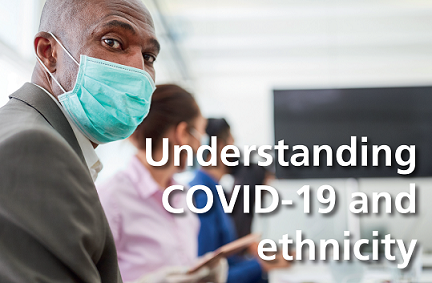Dr Claire Neil and Maurice Meehan - Public Health Agency

COVID-19 has had a disproportionate impact on people from Black, Asian and Minority Ethnic (or BAME) backgrounds. We explore the emerging evidence surrounding health outcomes associated with the virus, and consider what the growing literature tells us in order to understand these outcomes further. This is vital in informing our public health response to the pandemic in Northern Ireland.
What does the evidence tell us?
A review by Public Health England into the risk and outcomes associated with COVID-19 concludes that there is an association between ethnicity and both testing positive from, and risk of death with COVID-19. They establish that the highest rates of COVID-19 diagnosis (adjusting for age) were in people of Black ethnic groups, with the lowest being in people of White ethnic groups.
Recent statistics issued by the Intensive Care National Audit and Research Centre, including data from England, Wales and Northern Ireland, have shown that 38.6% of individuals critically ill in intensive care with COVID-19 since the start of September 2020 are from BAME backgrounds. This is likely to be a higher proportion than is represented in the general population from BAME backgrounds.
A provisional analysis of COVID-19 related death data, considering the potential influence of ethnicity, has been published by the Office for National Statistics (ONS) based on a review of death data from England and Wales. The provisional analysis helpfully adjusts for the individual effects of age, sex, deprivation and region, and has shown that the risk of death involving COVID-19 is significantly higher amongst some ethnic groups, including Black, Bangladeshi and Pakistani, Indian, and Mixed ethnic backgrounds, compared with those of White ethnicity.
What do we know about why the differences may exist?
The answer to this is likely to be quite complex. An extensive programme of research, funded by the National Institute for Health Research is currently underway, aims to investigate the higher risk of COVID-19 among certain ethnic groups. Although evidence continues to emerge, what is already clear is the influence of cultural, societal, and behavioural factors, all of which appear to account for some of the differences in risk. Although based on data from England and Wales, the ONS show that differences in risk of death from COVID-19 is partly the result of socio-economic disadvantage and other unexplained factors.
Additional literature and wider stakeholder engagement exercises undertaken by PHE indicate that individuals from BAME groups in the UK are also more likely to face housing challenges, which may exacerbate COVID-19 transmission, morbidity and mortality. They also are more likely to work in key worker jobs with higher risk of exposure, and report being more likely to use public transport to reach their place of work.
There may additionally be a concern that some individuals experience poorer access to healthcare, or may be less likely to seek care when needed, and may unfortunately experience or fear racism. Communication and understanding are also important considerations in relaying COVID-19 specific advice and information to all communities.
Some evidence has also shown that when comorbidities are considered, the difference in risk between ethnic groups among hospitalised patients is greatly reduced, so other underlying illness is also an important risk factor. We need to be sensitive to the data and related patterns of increased risk as these are primarily from England. Numbers of people from Bangladeshi, Pakistani and Indian backgrounds, who were identified as at particular risk, are relatively low in Northern Ireland. However, we do have significant populations of Traveller, Bulgarian and Romanian Roma and East Timorese who experience considerable relative economic disadvantage and for whom housing and workplace health factors increase risks.
What can we do about it?
Although we don’t yet have enough data to understand all of the potential links, there are likely to be many reasons why people from BAME communities have been impacted more by COVID-19. The influencing factors are complex.
Consequently, the PHA have ensured dedicated resources to addressing the health and wellbeing needs of BAME Groups, working particularly with community and voluntary sector partners such as STEP (South Tyrone Empowerment Project) to decrease risks of COVID-19. Further work on developing more data based on ethnic background is required.
